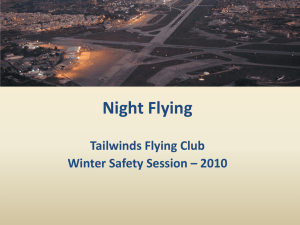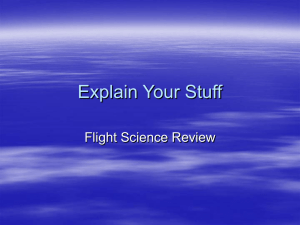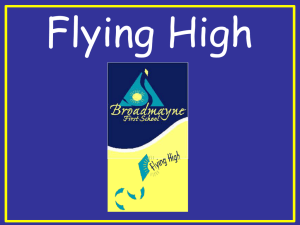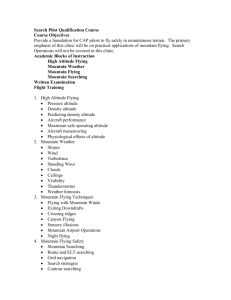South African Powered Paragliding Theoretical Knowledge Test
advertisement
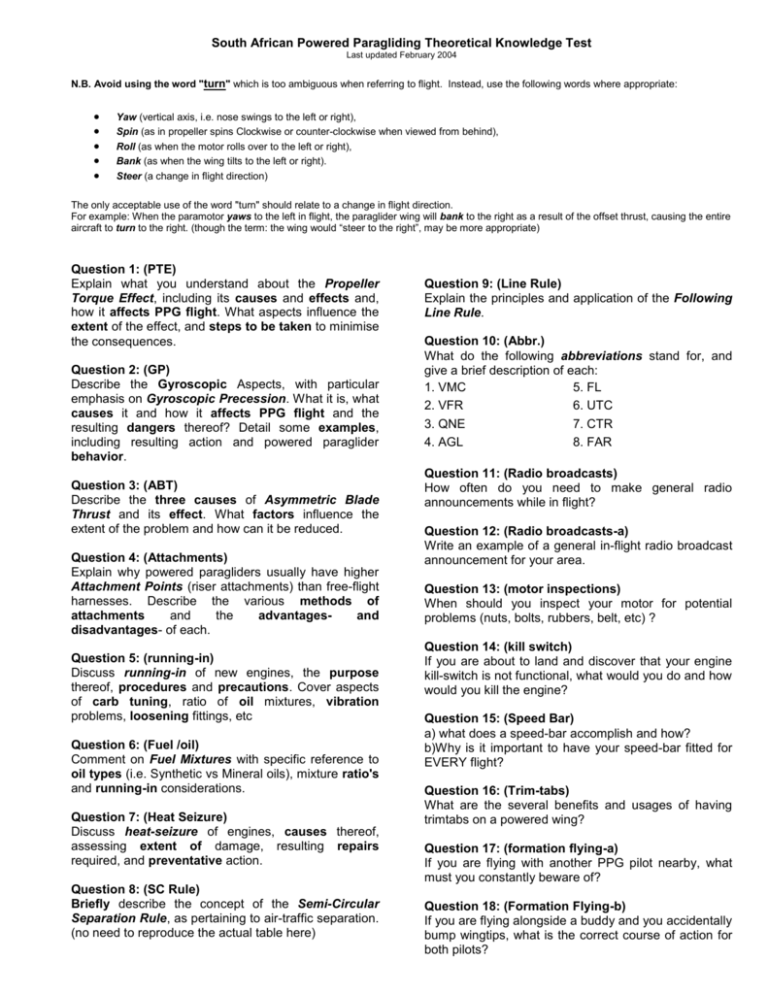
South African Powered Paragliding Theoretical Knowledge Test Last updated February 2004 N.B. Avoid using the word "turn" which is too ambiguous when referring to flight. Instead, use the following words where appropriate: Yaw (vertical axis, i.e. nose swings to the left or right), Spin (as in propeller spins Clockwise or counter-clockwise when viewed from behind), Roll (as when the motor rolls over to the left or right), Bank (as when the wing tilts to the left or right). Steer (a change in flight direction) The only acceptable use of the word "turn" should relate to a change in flight direction. For example: When the paramotor yaws to the left in flight, the paraglider wing will bank to the right as a result of the offset thrust, causing the entire aircraft to turn to the right. (though the term: the wing would “steer to the right”, may be more appropriate) Question 1: (PTE) Explain what you understand about the Propeller Torque Effect, including its causes and effects and, how it affects PPG flight. What aspects influence the extent of the effect, and steps to be taken to minimise the consequences. Question 2: (GP) Describe the Gyroscopic Aspects, with particular emphasis on Gyroscopic Precession. What it is, what causes it and how it affects PPG flight and the resulting dangers thereof? Detail some examples, including resulting action and powered paraglider behavior. Question 3: (ABT) Describe the three causes of Asymmetric Blade Thrust and its effect. What factors influence the extent of the problem and how can it be reduced. Question 4: (Attachments) Explain why powered paragliders usually have higher Attachment Points (riser attachments) than free-flight harnesses. Describe the various methods of attachments and the advantagesand disadvantages- of each. Question 5: (running-in) Discuss running-in of new engines, the purpose thereof, procedures and precautions. Cover aspects of carb tuning, ratio of oil mixtures, vibration problems, loosening fittings, etc Question 6: (Fuel /oil) Comment on Fuel Mixtures with specific reference to oil types (i.e. Synthetic vs Mineral oils), mixture ratio's and running-in considerations. Question 7: (Heat Seizure) Discuss heat-seizure of engines, causes thereof, assessing extent of damage, resulting repairs required, and preventative action. Question 8: (SC Rule) Briefly describe the concept of the Semi-Circular Separation Rule, as pertaining to air-traffic separation. (no need to reproduce the actual table here) Question 9: (Line Rule) Explain the principles and application of the Following Line Rule. Question 10: (Abbr.) What do the following abbreviations stand for, and give a brief description of each: 1. VMC 5. FL 2. VFR 6. UTC 3. QNE 7. CTR 4. AGL 8. FAR Question 11: (Radio broadcasts) How often do you need to make general radio announcements while in flight? Question 12: (Radio broadcasts-a) Write an example of a general in-flight radio broadcast announcement for your area. Question 13: (motor inspections) When should you inspect your motor for potential problems (nuts, bolts, rubbers, belt, etc) ? Question 14: (kill switch) If you are about to land and discover that your engine kill-switch is not functional, what would you do and how would you kill the engine? Question 15: (Speed Bar) a) what does a speed-bar accomplish and how? b)Why is it important to have your speed-bar fitted for EVERY flight? Question 16: (Trim-tabs) What are the several benefits and usages of having trimtabs on a powered wing? Question 17: (formation flying-a) If you are flying with another PPG pilot nearby, what must you constantly beware of? Question 18: (Formation Flying-b) If you are flying alongside a buddy and you accidentally bump wingtips, what is the correct course of action for both pilots? Question 19: (over water) If you are flying near the coast (or lake or dam), what is a safe distance and height to go out over the water? Question 20: (Log book) Why would you log your flying hours? a) to record progress b) for licensing and renewal purposes c) proof of experience and licenses received d) to keep track of engine hours for servicing intervals e) all of the above. Question 21: (safety altitude) If you double your flying height above the ground, by what factor is the landing area you can reach by gliding increased? (in the event of an engine-out) a) Double b) Triple c) Four times d) 50% Think carefully about Landing AREA ! Question 22: (Clouds) How far do you need to remain away from clouds? a) Vertically and b)horizontally Question 23: (sunset flying) When flying around sunset, what is the latest you may remain in the air? Question 24: (Tandem flying) In terms of (a) licensing and (b) equipment, what do you need before you may take a passenger for a tandem flight on your paramotor? Question 25: Mark each one True or False: A lighter all-up take-off weight will increase: a) Climb rate. b) Take-off distance. c) Power off stall speed d) Power on stall speed Question 26: Mark each one True or False: A heavier all-up take-off weight will increase: a) overall airspeed b) stall speed c) take-off run d) internal cell pressure Question 27: The _________ is an imaginary straight line drawn through an airfoil (wing) from the leading edge to the trailing edge. a) angle of attack. b) camber fine c) chord line d) relative wind line Question 28: Angle of attack is defined as: a)The angle between the horizon and the chord line b) The angle between the horizon and the relative wind c) The angle between the wing chord line and the pilot d) The angle between the wing chord line and the relative wind Question 29: Mark each one True or False: A stall occurs when: a) The critical angle of attack is exceeded. b) The nose is too high above the horizon. c) The airspeed gets too low. d) The engine quits at a bad time. Question 30: Trimspeed is defined as: a) flying off the brakes, off speedbar, and trimtabs set to neutral b) flying off the brakes, on maximum speedbar c) flying at 50% throttle setting d) flying as slowly as possible Question 31: In heavy turbulence it is safest to minimise deflations by flying: a) Downwind. b) At as high a speed as possible. c) At a very slow speed d) At Trimspeed Question 32: Mark each one True or False: You are on a head-on collision course with another aircraft in open areas. You should avoid the other aircraft by: a) Turning to the right b) turning to the left c) climbing d) diving Question 33: You are flying north in straight and level flight with an airspeed of 38kph. The wind at your altitude is from 180 degrees at 10 km/h. What is your groundspeed? a) 38 kph b) 48 kph c) 28 kph d) 10 kph Question 34: A magnetic compass is accurate: a) With the powered paraglider in any attitude b) Only when the airplane operated below maneuvering speed c) At all times d) Only when the airplane is operated in straight and level flight at constant speed Question 35: You would most likely find turbulent flying in conditions near: a) Stratus clouds b) Fog c) Cirrus clouds d) Cumulus clouds Question 42: What frequency is used for emergency communications a) 126.7 Mhz b) 124.8 Mhz c) 130.35 Mhz d) 121.5 Mhz Question 36: You would likely find turbulence a) near mountains b) in the mid afternoon c) deep inland d) downwind of buildings e) all of the above Question 43: Mark each one True or False: Take off run distance is increased by: a) Lighter headwind b) Higher Altitude c) Higher Humidity d) Lower QNH Question 37: Why does SAHPA exist? a) to keep the sport self regulating b) to provide 3rd party aviation insurance c) to provide a safety orientated licensing system d) to provide international recognition to the sport e) all of the above Question 44: Mark each one True or False: Carb mixture adjustment should be a) richened for lower altitudes b) richened for higher QNH c) richened for lower humidity Question 38: What is the very last safety action to perform prior to starting an engine? a) check the fuel/oil ratio on the fuel. b) check for sufficient fuel quantity. c) do a pre-flight inspection. d) yell “Clear prop” and verify that the prop area is clear of personnel. Question 39: Considering density altitude, your motor and wing would perform better on a) warm humid days. b) cold humid days. c) warm dry days. d) cold dry days. Question 40: When may you enter a Restricted Area (FAR)? a) Never! b) After receiving permission from the appropriate authority. c) Whenever you wish with extreme caution d) Only on weekends when the areas are closed. Question 41: When may you enter a Prohibited Area (FAP)? a) Never! b) Only with a written waiver from the CAA Administrator or his designee. c) With verbal permission from the controlling agency d) Anytime after official sunset and before official sunrise Question 45: Mark each one True or False: Which of the following is true: a) below 1500 foot AGL, the altimeter subscale is set to local QNH b) below 1500 foot AGL, radio your altitude in Feet. c) above transition altitude, the altimeter subscale is set to QNE d) When the altimeter subscale has been changed to QNE, radio your altitude in "Flight Level" Question 46: Which one is true: Rate of climb is a) affected by your throttle setting, unaffected by the windspeed and direction b) increased in a headwind, reduced in a tailwind Note: RATE of climb refers to your vario reading, i.e. meters per second Question 47: Mark each one True or False: Angle of climb is a) increased in a headwind b) increased with added power c) reduced at faster airspeed trim d) reduced in turns Question 48: When Taking off in thermic conditions, you are 10 meters up when you fly into a thermal. The glider Pitches back, your reaction is. a) Stay on full power and increase break pressure b) Come to Idle power immediately and pump the breaks c) maintain 3/4 power and catch the pendulum as the glider surges forward d) do nothing e) Scream

